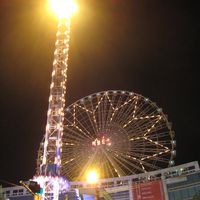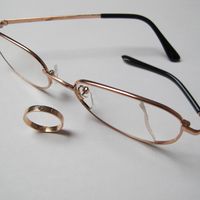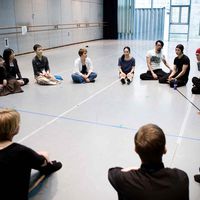Nomadic artists
 Judith Staines, Culture360.org’s Europe Editor, met Spanish artists Jasmina Llobet & Luis Fernández Pons in October 2010 during their residency at Seoul Art Space Geumcheon in Korea. She asked them about their nomadic lives as visual artists working in both Europe and Asia, learned about dislocation, communication barriers and different perceptions of time, and reflects on the opportunities and challenges of international mobility for artists.
Judith Staines, Culture360.org’s Europe Editor, met Spanish artists Jasmina Llobet & Luis Fernández Pons in October 2010 during their residency at Seoul Art Space Geumcheon in Korea. She asked them about their nomadic lives as visual artists working in both Europe and Asia, learned about dislocation, communication barriers and different perceptions of time, and reflects on the opportunities and challenges of international mobility for artists.Jasmina Llobet and Luis Fernández Pons are visual artists from Barcelona. They have been based in Berlin since 2001 where they studied Fine Art and started working collaboratively as Llobet & Pons. Their artistic practice focuses on the broad concept of everyday objects and the language of things, these ideas being the starting point for various multidisciplinary projects. They undertake residencies abroad on a regular basis - both in Europe and Asia - and are based at Seoul Art Space Geumcheon in 2010 for a 3-month residency under an international programme with Hangar in Barcelona.
JS: Tell me about your nomadic life as artists.
[caption id="attachment_7047" align="alignright" width="480" caption="Animal Tower. Intervention in public space, Anyang, South Korea, 2008. Construction of iron and glass, rabbits, hens, turtles, fishes."]
L&P: Rather than travelling we like to stay for a period of time in a different place. In the summer of 2008 we had the opportunity to work in South Korea for three months with a residence at Seoksu Art Project. In the working process we got very close to Korean culture and living there made a deep impression on us. We immersed ourselves in the context, observed and analysed the most simple things around us, and after a careful study, could develop a critical view and reflect on the learning experience.
Our aim has been to create projects that truly relate to the given context, even if they are completely different artistically from everything we have done up to that moment. After our stay in Korea we felt the need to keep working in that way and during the last two years we participated in residency programmes in Fukuoka (Studio Kura) Dublin (IMMA), Istanbul (Platform Garanti) and again Seoul. In between we returned each time for short stays to Berlin, where we have been based for more than nine years.
Perhaps after a while we have developed a need to be in constant dislocation, a need for staying in places which are not totally our place.
JS: You have done several residencies and projects in Asia – how do you find working in Korea and Japan compared to Europe?
L&P: Not comfortable at first, but challenging and fascinating after a while. At the beginning misunderstanding seems to be the rule: streets have no names, orientation is impossible (and where is a map? There are no maps sometimes or they are only in Korean), asking for a meal in a restaurant means you pointing at your neighbour's plate, you have to ask for help with translation for just ordering something in a shop, and online ordering is quite out of the question. So even the simplest thing can become a big issue if you plan an art project. This can be frustrating or instead you can enjoy the surreal situations and have fun. But after a couple of months you will probably go for the second option. We like to consider these misunderstandings and difficulties just part of the artistic process and they have actually become an amazing inspiration for our projects.
Of course the language barrier is also a problem. But there is a “gesture-barrier” too: one cannot actually rely on body language for communication and often gestures are not understood or mean different things. These mistakes cause memorable “lost in translation” moments. Fortunately, learning languages is a great passion of ours, so we always try to learn basic phrases and useful expressions, or at least know some words to make ourselves understood. We started learning Chinese some years ago and then learned Japanese Hiragana and Katakana. We learned the Korean alphabet from friends and quite a lot of words and expressions from everyday life.
As visual artists working with everyday objects, one of the most interesting experiences was to discover that things in these countries are not always what they appear, or at least not what you expect them to be. For example the taste of grapes, garlic or watermelon is different, the texture of water is slightly thicker, toilets have heated seats, and there are strange objects whose function we are not sure of. We started experiencing things just as if we were seeing them for the very first time.
JS: Residencies are relatively short: what strategies do you have to engage with the local community and environment?
L&P: Little acts of adaptation like learning the language is one, and also we try to immerse ourselves as much as possible in everyday life. A strange new place always causes us a shock at first, but at the same time it allows us to focus on aspects of things we would have never thought about in our usual environment.
One of the most important things for us is to develop our projects in accordance with the given context. It would not make sense to go to a place, ignore everything around and just create works that could have been made elsewhere. On the other hand, we never have the expectation of becoming a local – if this is possible at all – but rather to engage in an intense exchange and learning experience.
The good thing about residencies is that it is not a tourist visit and it is not your home. Even if they are short-term projects, the time frame is wide enough to investigate and go deeper into a certain subject. In contrast to a tourist experience, we think that in a residency art project it is possible and necessary to develop a critical view and intervene in the reality of the place.
JS: Do you maintain many contacts with artists you meet abroad and residency spaces? How do you keep in touch and develop your networks?
L&P: Let us explain about our personal experience with our Korean friends. For many years it was difficult to maintain contact with them and we didn't know why. It felt like there was a huge communication barrier, even if the internet allowed us to be in contact. In contrast, for keeping in touch between themselves, people in Korea were very actively using social networking websites like Cyworld and were always in touch. That was already back in 2004-05. Unfortunately, we could never open up an account in Cyworld, not only because of the language, but because apparently it was reserved exclusively for Korean citizens.
Then, when visiting Korea for the first time in 2008 we got to understand many things. We encountered a different way of understanding communication. Internet, e-mail and cell phones were used differently from in Europe. The whole system was new and fascinating to us.
The situation is now very different. Since last year Koreans started using Facebook intensively. That made a drastic change in the whole problem of maintaining contact with them. Due to technological developments and the popularisation and unification of social networking websites, we now can be constantly in contact with our Korean friends. It is strange and interesting to see how technology can affect our perception of things and our relations to other people.
JS: As artists from Barcelona, living in Berlin and working around the world, where is home?
L&P: Being at home time passes by very differently from being away. In our normal habitat we don't encounter many unexpected situations. Stimuli from the outside are kept to a reasonable level and are always “under control”. Being in a strange environment gives us a new perception of time. Three months can feel just like a whole year, full of experiences and memories. We like to think about home not as a concrete place but rather as the way time passes by.
While being home make us feel safe, the feeling of “not being home“ is thrilling and mostly unleashes the starting point for our projects.
---------------------------------------------------
Llobet & Pons give a fascinating insight into the motivations and everyday experiences of artists who choose to lead nomadic lives, pursuing residency opportunities that take their artistic practice out of the ‘comfort zone’ and allow for an intense and distinctive experience of time and place. Such processes can generate new artistic approaches and create unique networks of communication between artists worldwide.
The Seoul Art Space Geumcheon residency took them to live and work in a former printing factory in the Seoul suburbs that now houses both local and international artists.

Seoul Art Space is a network of five centres around the city providing studio space and residencies. The project is a fine example of regeneration through culture of disused urban spaces: the well-appointed art centres are located in a former metal works, a print factory, empty shops, offices and defunct government buildings. Hee-Young Kim, Manager of Seoul Art Space Geumcheon, describes the cultural policy of the city government as “very dynamic” and indeed the mission of Seoul Foundation Arts and Culture, who runs the project for the City Government, is to make Seoul “the creative cultural city in the world”.
In 1996 Michael Haerdter, founding director of Künstlerhaus Bethanien in Berlin and first president of Res Artis network, referred to artists as “post-modern nomads” or “wanderers between cultures”. Haerdter explored the phenomenon of post-modern nomadism in a presentation to Res Artis in Dublin:
“Migrating artists belong with the many transcultural messengers of a world whose keywords are nomadism and globalism. The post-modern invention and worldwide spreading of residential arts centres […] corresponds to the need of artists and intellectuals to experience the world and its many environments and cultures, to realise in situ research and projects, to be temporarily part of creative communities and to profit from the opportunity they offer for exchanging ideas and know-how.”
Fifteen years on, Michael Haerdter’s observations on nomadic artists and residencies retain their poetic resonance. Since then international mobility has become ever more ubiquitous and an essential element of any professional artist’s career. Now, as artistic mobility comes under pressure from new challenges, some artists and residency centres find they must review its environmental sustainability, justify the economic value and find arguments in the face of migration restrictions.
The 2010 a.RTISTS IN TRANSIT project by IGBK - who represent visual artists in Germany - is a weblog about travelling artists and their everyday experiences. It asks important questions. Why does mobility take place? What are the personal gains and drawbacks? What do artists find out there by entering new art scenes? And what daily difficulties do they meet? This is a response by IGBK to the highly mobile international art scene, communicating the experience directly and complementing IGBK’s policy engagement on cultural mobility.
As Llobet & Pons demonstrate, artists’ residencies can offer interesting spaces for an artistic practice located in constant dislocation. Part-incubator, part-haven, part-platform, residencies invite artists to confront the lack of security and inevitable miscomprehensions that accompany temporary nomadism and to immerse themselves in the reality of another place. It’s not for everyone, but the aspiration to engage in an intense exchange and learning experience seems valid and relevant in an increasingly dislocated world.
More resources:
- Residencies section of Culture360.org
- Res Artis, the worldwide network of artist residencies, has a new website - search by residency (art discipline, country etc.) or by deadline and read residency experiences
- Trans Artists in the Netherlands is a knowledge centre on artist-in-residence opportunities across the world: check the database, current deadlines, artists experiences and the useful checklist for artists.
- AIR_J provides information on artist-in-residence opportunities across Japan
- Conteners art project in Paris organised a European symposium on artistic nomadism in 2008 and collected a database of nomadic arts projects around the world.
Similar content
29 Jun 2012
23 Apr 2012






